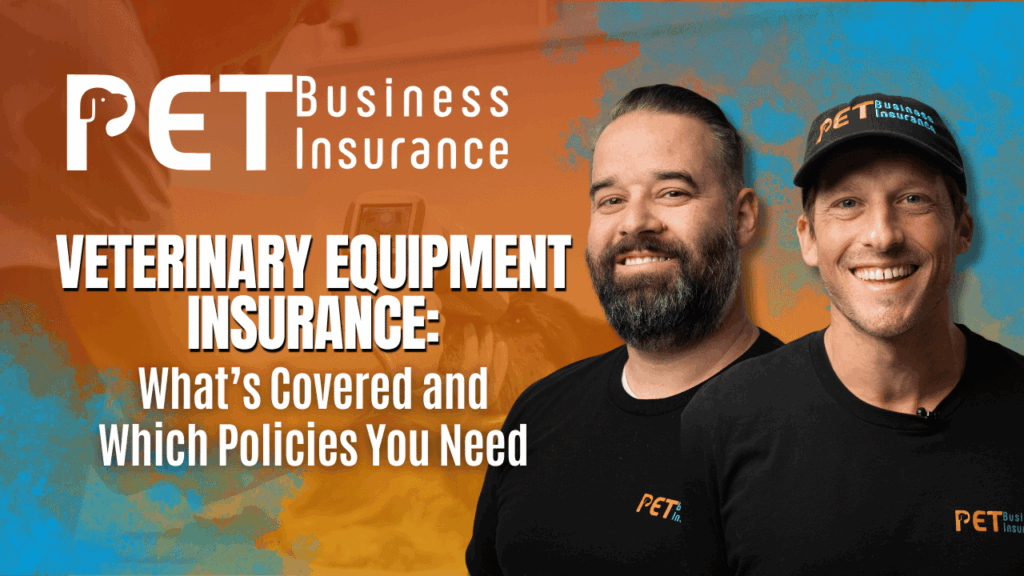
Starting a veterinary clinic requires a significant financial investment, often nearing $1,000,000. A large portion of this goes toward acquiring critical medical equipment—from radiography machines and surgical instruments to examination tables and anesthesia systems. When this equipment fails or is damaged, the costs to repair or replace it can severely disrupt operations or even jeopardize the survival of a practice.
This guide covers the major types of insurance that protect veterinary equipment, including real-world risk scenarios, cost breakdowns, and comparisons of coverage from leading providers. By understanding the risks and insurance options, practice owners can safeguard their investment and ensure continuity of care for their patients.
Why Insurance for Veterinary Equipment Is Essential
Veterinary equipment is expensive, heavily used, and exposed to demanding environments. Without adequate insurance, a single equipment failure can become a financial crisis.
Significant Capital at Risk
A modern veterinary clinic’s equipment list includes anesthesia machines ($15,000–$30,000), digital radiography systems ($40,000–$100,000), surgical lasers ($20,000–$50,000), and laboratory tools (often exceeding $25,000). When you factor in portable equipment, IT systems, and specialized tools, the total value quickly adds up.
Common Equipment Failure Scenarios
- Power surges: Electrical storms or faulty wiring can destroy sensitive electronics.
- Water damage: Floods or plumbing failures can ruin equipment and require costly cleanup.
- Motor burnout: Continuous operation leads to mechanical failures in centrifuges and ventilators.
- Operator error: Accidental misuse of equipment during high-stress emergencies is common.
- Theft or vandalism: Portable equipment and computers are high-value targets.
Business Impact of Equipment Loss
Beyond the cost of replacing damaged equipment, practices face:
- Lost revenue from canceled appointments
- Expenses for temporary rental equipment
- Staff overtime to manage manual processes
- Long-term reputational damage from service disruptions
Real-World Loss Examples
Fire Damage
A fire damages a clinic’s radiography system, analyzers, and computer systems. While equipment replacement costs $200,000, additional costs from reduced capacity, equipment rental, and labor bring the total loss to $420,000.
Power Surge
A thunderstorm causes a surge that damages multiple diagnostic tools. Though each item is relatively low cost, total replacement exceeds $75,000. Secondary failures emerge months later, compounding costs.
Water Pipe Burst
A burst pipe floods a treatment area over the weekend. The result: $100,000 in equipment losses, temporary relocation costs, and contaminated records that disrupt patient care.
Types of Insurance That Protect Veterinary Equipment
Understanding which policy types apply to different risks is essential for comprehensive protection.
Commercial Property Insurance
This foundational policy covers physical equipment located at your practice. It protects against:
- Fire, storms, and vandalism
- Theft of tools and electronics
- Burst pipes and water damage
- Structural damage to the building
Equipment covered includes radiography systems, surgical instruments, anesthesia machines, scales, and more. Property insurance may also include business personal property coverage, protecting portable items used off-site.
Equipment Breakdown Insurance
Covers internal failures not included in standard property policies:
- Power surge damage to electronic systems
- Motor burnout in lab equipment or HVAC units
- Steam boiler or sterilizer failures
- Operator error causing internal damage
This type of insurance covers the cost to repair or replace failed components and may include rush delivery and emergency labor services.
Business Owner’s Policy (BOP)
A BOP bundles multiple protections into one policy:
- Commercial property for physical assets
- General liability for injury/damage caused by business operations
- Business income for lost revenue during recovery from equipment failures
Some BOPs also include computer equipment coverage and spoilage protection for vaccines and medications in refrigeration systems.
Inland Marine Insurance
Designed for equipment that is mobile or used off-site. Covers:
- Mobile veterinary units
- Equipment transported to farms or homes
- Tools used at pop-up clinics or events
It also covers loss or damage during transport, theft from vehicles, or environmental exposure outside your clinic.
Cyber Liability Insurance
Protects your practice when digital systems are attacked:
- Covers hardware and software damage from cyber attacks
- Pays for data recovery, system restoration, and legal expenses
- Helps manage costs from credit monitoring, breach notification, and PR
This insurance is essential as practices increasingly rely on connected equipment and digital records.
Valuable Papers and Records Coverage
Covers the cost to recreate or recover physical and digital records after a covered loss. This includes:
- Medical histories
- Lab results
- Prescription records
- Client and billing data
Even if physical equipment is insured, the loss of irreplaceable records can severely impact operations.
Budgeting for Equipment Insurance
Typical Cost Breakdown
For a standard small animal practice:
- Property insurance: ~$800/year per $100,000 in coverage
- Equipment breakdown: Typically bundled into BOPs
- Professional liability: $250–$1,700/year depending on limits
- Workers’ comp: ~$4,500/year for full staff coverage
- Cyber insurance: Varies by practice size and revenue
Premiums are influenced by location, equipment value, claim history, and deductible selection.
Cost vs. Risk
A single equipment loss can exceed $100,000, while comprehensive coverage typically costs $6,000–$10,000 annually. Insurance is one of the most cost-effective forms of risk management a practice can implement.
What to Know About the Claims Process
To ensure smooth resolution:
- Maintain an updated inventory of all equipment
- Document model numbers, purchase dates, and values
- Photograph damage before any repairs or cleanup
- Report claims within 24–48 hours
- Preserve failed equipment for adjuster review
Common exclusions include normal wear and tear, lack of maintenance, and damage from uncovered perils like earthquakes or floods unless add-ons are purchased.
Risk Management Best Practices
Insurance is only part of the strategy. You should also:
- Conduct regular maintenance on all equipment
- Train staff in proper handling and storage procedures
- Install surge protection, climate control, and water detection systems
- Store backup copies of digital records off-site or in the cloud
- Review insurance policies annually, especially after new equipment purchases or expansions
Final Thoughts
Veterinary equipment is one of your practice’s most valuable assets and also one of its greatest liabilities in the event of loss or damage. Comprehensive insurance—including property, breakdown, cyber, and mobile protection—can mean the difference between a temporary disruption and a permanent closure.
Review your current coverage, assess your practice’s risks, and ensure you’re fully protected for the long term.

